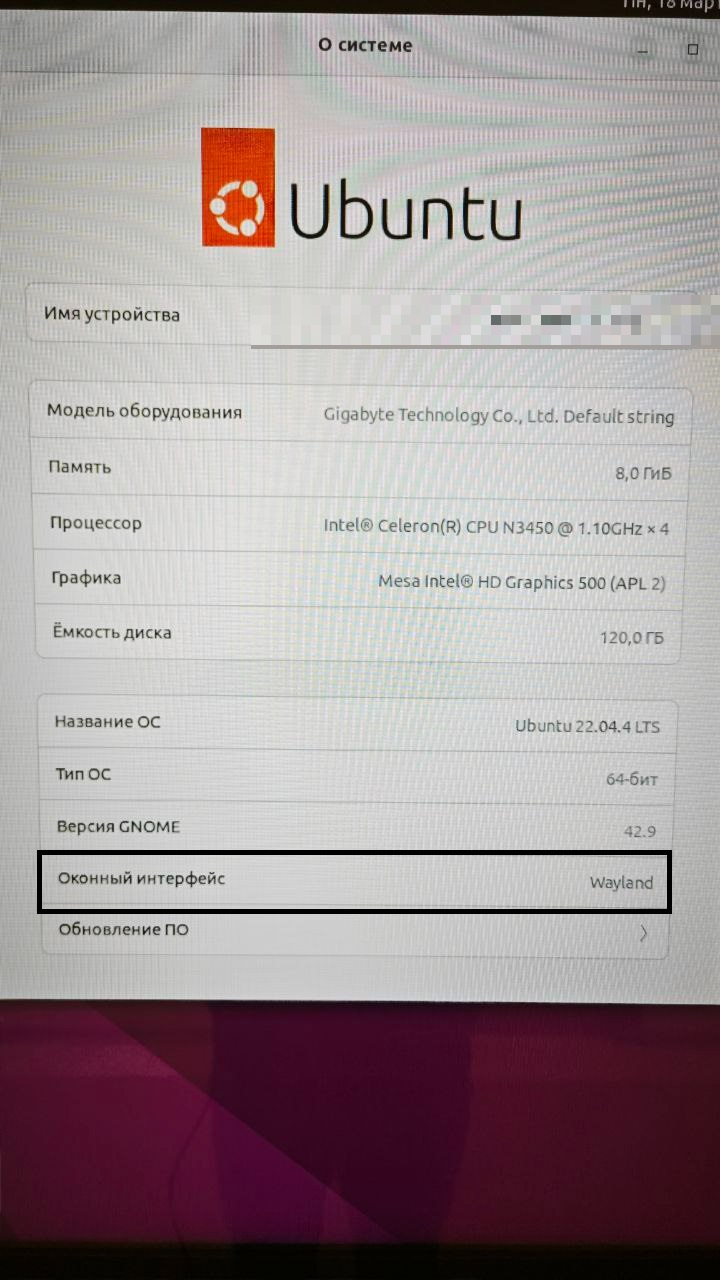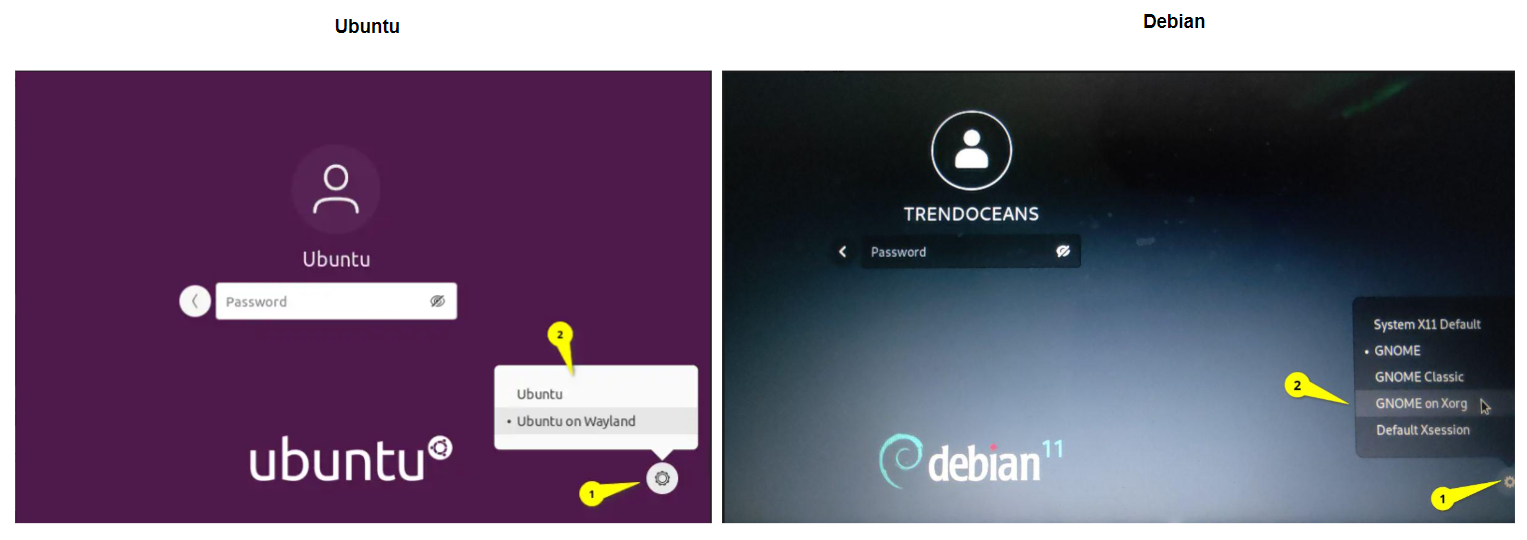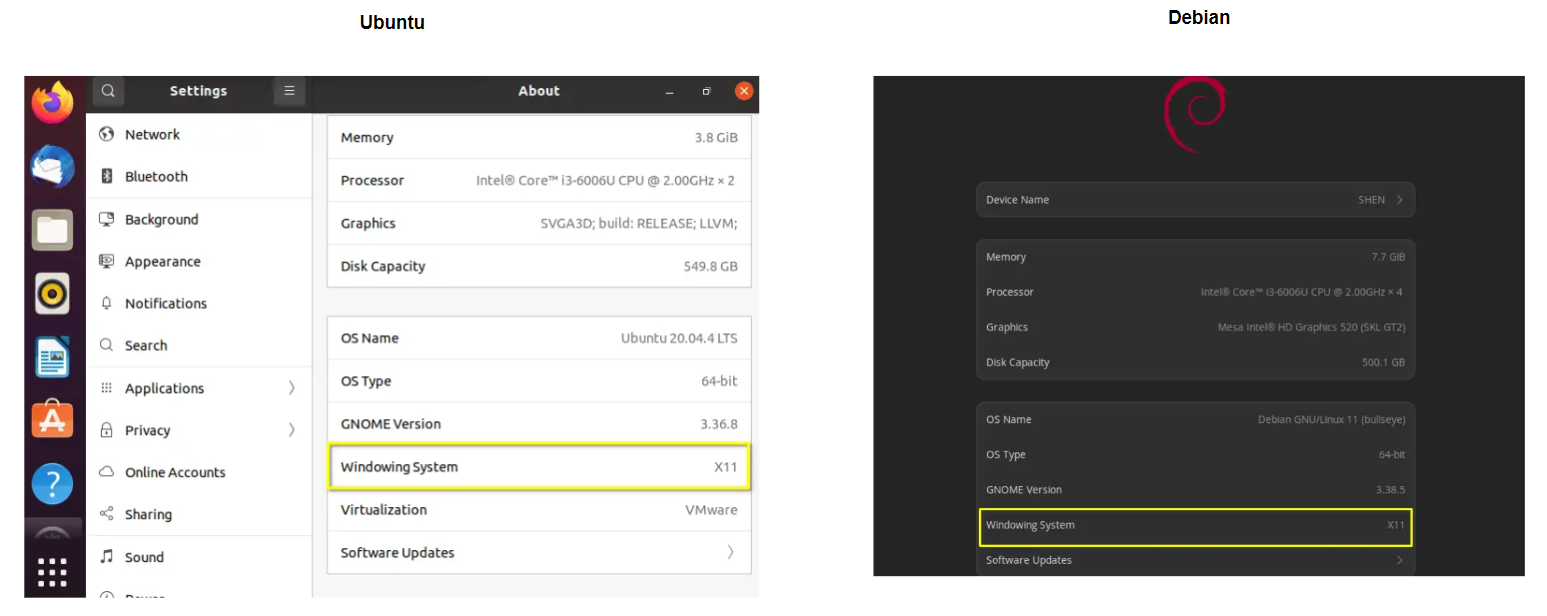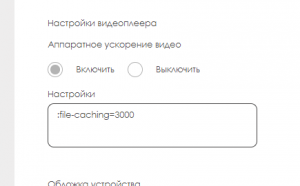Linux/en: различия между версиями
FuzzyBot (обсуждение | вклад) Обновление для соответствия новой версии исходной страницы. |
FuzzyBot (обсуждение | вклад) Обновление для соответствия новой версии исходной страницы. |
||
| (не показано 15 промежуточных версий 2 участников) | |||
| Строка 1: | Строка 1: | ||
<languages/> | <languages/> | ||
== Minimum Requirements == | |||
== Minimum | * OS: Ubuntu Desktop 16.04 | ||
* OS: | * Processor: Intel Celeron 1.6 GHz (J3160). <br> | ||
* Processor: Intel Celeron 1.6 GHz (J3160). <br> | * RAM: 2 GB. <br> | ||
* RAM: 2 GB. <br> | * Graphics card: integrated Intel HD Graphics 400. <br> | ||
* Graphics: | |||
* Disk space: 35 GB. | * Disk space: 35 GB. | ||
== Recommended Requirements == | |||
* OS: Ubuntu Desktop 18.04 LTS / 22.04 LTS (support for 22.04 is only possible with the second version of the client application 2. ...) | |||
* Processor: Intel Nuc i3 or more powerful devices. <br> | |||
== Recommended Requirements == | * RAM: 4 GB. <br> | ||
* OS: | * Graphics card: external graphics card. <br> | ||
* Processor: Intel Nuc i3 or | |||
* RAM: 4 GB. <br> | |||
* | |||
* Disk space: 100 GB. | * Disk space: 100 GB. | ||
== Installation == | |||
''The SmartPlayer company has experience launching the client application on Ubuntu 16.04 (x32/x64), Ubuntu 18.04 (x64), and Ubuntu 20.04 (skipped by SmartPlayer, and the client application was not launched). Here, we recommend the latest version, Ubuntu 22.04.04 LTS, for stable operation. If the project uses outdated operating systems mentioned above, we can create a custom distribution package, request it from the project manager.'' | |||
== Installation == | |||
=== Installation Steps === | |||
First, install the operating system: | |||
# Install Ubuntu 22.04.04 LTS [https://releases.ubuntu.com/jammy/ Download from the official website] | |||
# Operating system setup: | |||
## Before installing the application, you need to change the operating system settings via the graphical interface. [https://drive.google.com/file/d/1LVVqamuGO3O8UH0T5CKtaxdcl-Jlkm54/view?usp=sharing Linux instruction] | |||
## Disable the screensaver and sleep mode - [[Linux/LockScreen|Инструкция]] | |||
## Install proprietary drivers for graphics cards - [[Linux/VideoDrivers|Инструкция]] | |||
## Disable system notification settings - [[Linux/Notify|Инструкция]] | |||
# Install the application via terminal '''$ sudo dpkg -i SmartPlayer_..*_api.smartplayer.org_x64.deb''' | |||
# Launch the application | |||
## You can launch the application from the application list | |||
## Launch the application via terminal '''$ /usr/bin/SmartPlayer/SmartPlayer.sh''' | |||
== | == Exiting Kiosk Mode == | ||
The application will start in kiosk mode. To exit, use the keyboard shortcut Ctrl+F12. | |||
== Removing the Application == | |||
Run the following command in the terminal: '''$ sudo dpkg --purge SmartPlayer''' | |||
== Running on Low-End Hardware == | |||
When running on computers with low specifications, video freezing and lagging may occur. To achieve better performance, you need to: | |||
# Upload the video to the built-in video editor in your personal account, adjust the video bitrate in the editor to an appropriate level (depending on the required quality), process it, and save it. Use the processed video in the broadcast. | |||
# In the personal account, go to the device settings and enable hardware acceleration. Settings - Hardware acceleration - enter the parameter | |||
:file-caching=3000 and save. | |||
[[File:21d2054fca88d7ae0fe8e8baada86184.png|300px]] | |||
== Troubleshooting == | |||
== | === The display does not turn off when the display timeout is set === | ||
To resolve the issue, first run the following command in the device's command line: '''xset dpms force off'''. If the display turns off, incorrect settings are configured in the SmartPlayer personal account. If the display does not turn off and the message '''server does not have extension for dpms option''' appears in the command line, you need to adjust the settings. The solution requires disabling Wayland in Ubuntu: | |||
# Run the command sudo nano /etc/gdm3/custom.conf | |||
# Remove the comment from the line #WaylandEnable = false (the text will be highlighted in white). | |||
[[File: | # Save (ctrl+O) | ||
< | # Run the command sudo service gdm3 restart | ||
[[File:Пример.png|300px|Example]]<br> | |||
== | === Window Interface Switching === | ||
When the user launches the application on Ubuntu, there is no response. | |||
To solve this issue, go to the "About" section and find the line "Windowing system." | |||
[[File:Смена_интерфейса.jpg|thumb|center| Location of the "Windowing system" setting.|300px]] | |||
In this line, change the option from "Wayland" to "X11." | |||
==== Alternative Solution ==== | |||
There is a possibility to switch from Wayland to the X11 display system from the lock screen. This method is suitable for those who do not have access to sudo to modify '''''"/etc/gdm3/daemon.conf"''''' or '''''"/etc/gdm3/custom.conf"''''', or if the user needs to temporarily switch from Wayland to the X11 display system. | |||
First, the user needs to log out of the system by running the command below or use the traditional method to log out of the system. | |||
[[File:Смена_интерфейса.jpg|thumb|center| | |||
==== | |||
<code>$ loginctl terminate-user $(users)</code><br> | <code>$ loginctl terminate-user $(users)</code><br> | ||
After this, press "Enter" to log back into the system. | |||
Next, the user should find the "gear" icon in the bottom-right corner. Clicking on it will open the parameter settings window. By default, Ubuntu users work on X11, but if they somehow find themselves on Ubuntu using Wayland, change it to "Ubuntu." For Debian-based users, choose "GNOME on Xorg." | |||
[[File:Пак_1.png|thumb|center| Example for Ubuntu and Debian.|300px]] After that, log back into the system and go to Settings -> About to verify the changes. In the "Windowing system" section, you will find X11 for Ubuntu and Debian-based users. | |||
[[File:Пак_1.png|thumb|center| | [[File:Пак_2.png|thumb|center| Example for Ubuntu and Debian.|300px]] | ||
[[File:Пак_2.png|thumb|center| | |||
= | '''Switching the Windowing System via Terminal''' | ||
* Open the terminal. | |||
# | * Enter the command ''sudo gedit /etc/gdm3/custom.conf''. | ||
# | * To disable "Wayland" mode, find the line ''#WaylandEnable=false'', remove the "#" symbol, and save the changes. | ||
* Restart "GDM" using the command ''sudo systemctl restart gdm3''. | |||
== Hardware Limitations of the Platform == | |||
Devices running Linux have the following hardware limitations: | |||
# Having an active antivirus or firewall can affect the SmartPlayer application's performance. | |||
# When reviewing the minimum system requirements for the device, the user should understand that these are specified for the proper operation of the SmartPlayer application alone, without considering other programs and processes that also consume device resources. Therefore, it is recommended to have a device configuration with more powerful components than those listed in the minimum system requirements. Otherwise, stable operation of the SmartPlayer application and its components is not guaranteed. | |||
Текущая версия от 21:12, 16 сентября 2024
Minimum Requirements
- OS: Ubuntu Desktop 16.04
- Processor: Intel Celeron 1.6 GHz (J3160).
- RAM: 2 GB.
- Graphics card: integrated Intel HD Graphics 400.
- Disk space: 35 GB.
Recommended Requirements
- OS: Ubuntu Desktop 18.04 LTS / 22.04 LTS (support for 22.04 is only possible with the second version of the client application 2. ...)
- Processor: Intel Nuc i3 or more powerful devices.
- RAM: 4 GB.
- Graphics card: external graphics card.
- Disk space: 100 GB.
Installation
The SmartPlayer company has experience launching the client application on Ubuntu 16.04 (x32/x64), Ubuntu 18.04 (x64), and Ubuntu 20.04 (skipped by SmartPlayer, and the client application was not launched). Here, we recommend the latest version, Ubuntu 22.04.04 LTS, for stable operation. If the project uses outdated operating systems mentioned above, we can create a custom distribution package, request it from the project manager.
Installation Steps
First, install the operating system:
- Install Ubuntu 22.04.04 LTS Download from the official website
- Operating system setup:
- Before installing the application, you need to change the operating system settings via the graphical interface. Linux instruction
- Disable the screensaver and sleep mode - Инструкция
- Install proprietary drivers for graphics cards - Инструкция
- Disable system notification settings - Инструкция
- Install the application via terminal $ sudo dpkg -i SmartPlayer_..*_api.smartplayer.org_x64.deb
- Launch the application
- You can launch the application from the application list
- Launch the application via terminal $ /usr/bin/SmartPlayer/SmartPlayer.sh
Exiting Kiosk Mode
The application will start in kiosk mode. To exit, use the keyboard shortcut Ctrl+F12.
Removing the Application
Run the following command in the terminal: $ sudo dpkg --purge SmartPlayer
Running on Low-End Hardware
When running on computers with low specifications, video freezing and lagging may occur. To achieve better performance, you need to:
- Upload the video to the built-in video editor in your personal account, adjust the video bitrate in the editor to an appropriate level (depending on the required quality), process it, and save it. Use the processed video in the broadcast.
- In the personal account, go to the device settings and enable hardware acceleration. Settings - Hardware acceleration - enter the parameter
- file-caching=3000 and save.
Troubleshooting
The display does not turn off when the display timeout is set
To resolve the issue, first run the following command in the device's command line: xset dpms force off. If the display turns off, incorrect settings are configured in the SmartPlayer personal account. If the display does not turn off and the message server does not have extension for dpms option appears in the command line, you need to adjust the settings. The solution requires disabling Wayland in Ubuntu:
- Run the command sudo nano /etc/gdm3/custom.conf
- Remove the comment from the line #WaylandEnable = false (the text will be highlighted in white).
- Save (ctrl+O)
- Run the command sudo service gdm3 restart
Window Interface Switching
When the user launches the application on Ubuntu, there is no response. To solve this issue, go to the "About" section and find the line "Windowing system."

In this line, change the option from "Wayland" to "X11."
Alternative Solution
There is a possibility to switch from Wayland to the X11 display system from the lock screen. This method is suitable for those who do not have access to sudo to modify "/etc/gdm3/daemon.conf" or "/etc/gdm3/custom.conf", or if the user needs to temporarily switch from Wayland to the X11 display system.
First, the user needs to log out of the system by running the command below or use the traditional method to log out of the system.
$ loginctl terminate-user $(users)
After this, press "Enter" to log back into the system.
Next, the user should find the "gear" icon in the bottom-right corner. Clicking on it will open the parameter settings window. By default, Ubuntu users work on X11, but if they somehow find themselves on Ubuntu using Wayland, change it to "Ubuntu." For Debian-based users, choose "GNOME on Xorg."

After that, log back into the system and go to Settings -> About to verify the changes. In the "Windowing system" section, you will find X11 for Ubuntu and Debian-based users.

Switching the Windowing System via Terminal
- Open the terminal.
- Enter the command sudo gedit /etc/gdm3/custom.conf.
- To disable "Wayland" mode, find the line #WaylandEnable=false, remove the "#" symbol, and save the changes.
- Restart "GDM" using the command sudo systemctl restart gdm3.
Hardware Limitations of the Platform
Devices running Linux have the following hardware limitations:
- Having an active antivirus or firewall can affect the SmartPlayer application's performance.
- When reviewing the minimum system requirements for the device, the user should understand that these are specified for the proper operation of the SmartPlayer application alone, without considering other programs and processes that also consume device resources. Therefore, it is recommended to have a device configuration with more powerful components than those listed in the minimum system requirements. Otherwise, stable operation of the SmartPlayer application and its components is not guaranteed.

